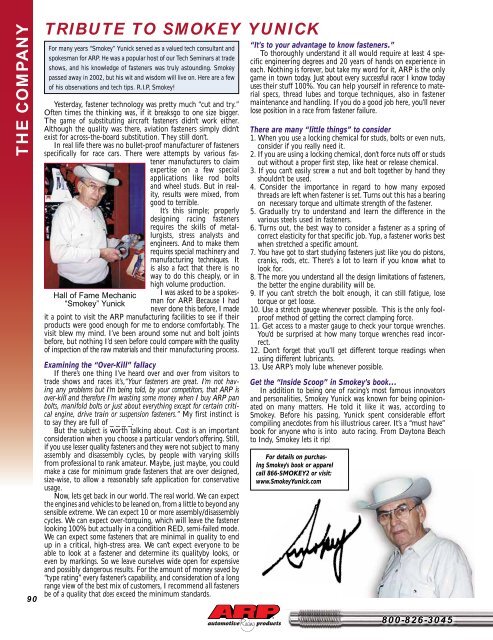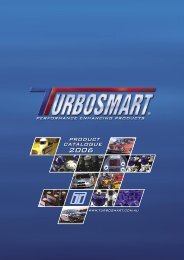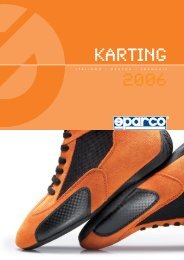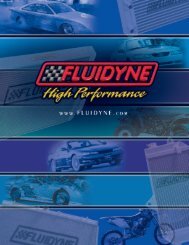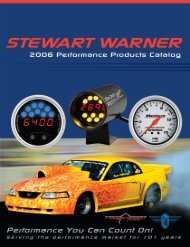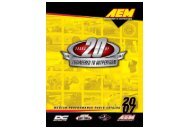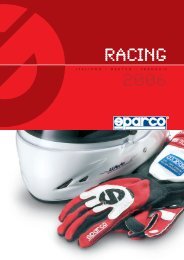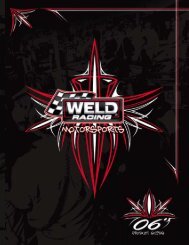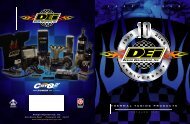Catalog Supplement for 2006 - JRP
Catalog Supplement for 2006 - JRP
Catalog Supplement for 2006 - JRP
Create successful ePaper yourself
Turn your PDF publications into a flip-book with our unique Google optimized e-Paper software.
THE COMPANY<br />
90<br />
TRIBUTE TO SMOKEY YUNICK<br />
For many years “Smokey” Yunick served as a valued tech consultant and<br />
spokesman <strong>for</strong> ARP. He was a popular host of our Tech Seminars at trade<br />
shows, and his knowledge of fasteners was truly astounding. Smokey<br />
passed away in 2002, but his wit and wisdom will live on. Here are a few<br />
of his observations and tech tips. R.I.P, Smokey!<br />
Yesterday, fastener technology was pretty much “cut and try.”<br />
Often times the thinking was, if it breaksgo to one size bigger.<br />
The game of substituting aircraft fasteners didn’t work either.<br />
Although the quality was there, aviation fasteners simply didn’t<br />
exist <strong>for</strong> across-the-board substitution. They still don’t.<br />
In real life there was no bullet-proof manufacturer of fasteners<br />
specifically <strong>for</strong> race cars. There were attempts by various fastener<br />
manufacturers to claim<br />
expertise on a few special<br />
applications like rod bolts<br />
and wheel studs. But in reality,<br />
results were mixed, from<br />
good to terrible.<br />
It’s this simple; properly<br />
designing racing fasteners<br />
requires the skills of metallurgists,<br />
stress analysts and<br />
engineers. And to make them<br />
requires special machinery and<br />
manufacturing techniques. It<br />
is also a fact that there is no<br />
way to do this cheaply, or in<br />
high volume production.<br />
Hall of Fame Mechanic<br />
“Smokey” Yunick<br />
I was asked to be a spokesman<br />
<strong>for</strong> ARP. Because I had<br />
never done this be<strong>for</strong>e, I made<br />
it a point to visit the ARP manufacturing facilities to see if their<br />
products were good enough <strong>for</strong> me to endorse com<strong>for</strong>tably. The<br />
visit blew my mind. I’ve been around some nut and bolt joints<br />
be<strong>for</strong>e, but nothing I’d seen be<strong>for</strong>e could compare with the quality<br />
of inspection of the raw materials and their manufacturing process.<br />
Examining the “Over-Kill” fallacy<br />
If there’s one thing I’ve heard over and over from visitors to<br />
trade shows and races it’s,“Your fasteners are great. I’m not having<br />
any problems but I’m being told, by your competitors, that ARP is<br />
over-kill and there<strong>for</strong>e I’m wasting some money when I buy ARP pan<br />
bolts, manifold bolts or just about everything except <strong>for</strong> certain critical<br />
engine, drive train or suspension fasteners.” My first instinct is<br />
to say they are full of _ _ _ _.<br />
But the subject is worth talking about. Cost is an important<br />
consideration when you choose a particular vendor’s offering. Still,<br />
if you use lesser quality fasteners and they were not subject to many<br />
assembly and disassembly cycles, by people with varying skills<br />
from professional to rank amateur. Maybe, just maybe, you could<br />
make a case <strong>for</strong> minimum grade fasteners that are over designed,<br />
size-wise, to allow a reasonably safe application <strong>for</strong> conservative<br />
usage.<br />
Now, lets get back in our world. The real world. We can expect<br />
the engines and vehicles to be leaned on, from a little to beyond any<br />
sensible extreme. We can expect 10 or more assembly/disassembly<br />
cycles. We can expect over-torquing, which will leave the fastener<br />
looking 100% but actually in a condition RED, semi-failed mode.<br />
We can expect some fasteners that are minimal in quality to end<br />
up in a critical, high-stress area. We can’t expect everyone to be<br />
able to look at a fastener and determine its qualityby looks, or<br />
even by markings. So we leave ourselves wide open <strong>for</strong> expensive<br />
and possibly dangerous results. For the amount of money saved by<br />
“type rating” every fastener’s capability, and consideration of a long<br />
range view of the best mix of customers, I recommend all fasteners<br />
be of a quality that does exceed the minimum standards.<br />
“It’s to your advantage to know fasteners.”<br />
To thoroughly understand it all would require at least 4 specific<br />
engineering degrees and 20 years of hands on experience in<br />
each. Nothing is <strong>for</strong>ever, but take my word <strong>for</strong> it, ARP is the only<br />
game in town today. Just about every successful racer I know today<br />
uses their stuff 100%. You can help yourself in reference to material<br />
specs, thread lubes and torque techniques, also in fastener<br />
maintenance and handling. If you do a good job here, you’ll never<br />
lose position in a race from fastener failure.<br />
There are many “little things” to consider<br />
1. When you use a locking chemical <strong>for</strong> studs, bolts or even nuts,<br />
consider if you really need it.<br />
2. If you are using a locking chemical, don’t <strong>for</strong>ce nuts off or studs<br />
out without a proper first step, like heat or release chemical.<br />
3. If you can’t easily screw a nut and bolt together by hand they<br />
shouldn’t be used.<br />
4. Consider the importance in regard to how many exposed<br />
threads are left when fastener is set. Turns out this has a bearing<br />
on necessary torque and ultimate strength of the fastener.<br />
5. Gradually try to understand and learn the difference in the<br />
various steels used in fasteners.<br />
6. Turns out, the best way to consider a fastener as a spring of<br />
correct elasticity <strong>for</strong> that specific job. Yup, a fastener works best<br />
when stretched a specific amount.<br />
7. You have got to start studying fasteners just like you do pistons,<br />
cranks, rods, etc. There’s a lot to learn if you know what to<br />
look <strong>for</strong>.<br />
8. The more you understand all the design limitations of fasteners,<br />
the better the engine durability will be.<br />
9. If you can’t stretch the bolt enough, it can still fatigue, lose<br />
torque or get loose.<br />
10. Use a stretch gauge whenever possible. This is the only foolproof<br />
method of getting the correct clamping <strong>for</strong>ce.<br />
11. Get access to a master gauge to check your torque wrenches.<br />
You’d be surprised at how many torque wrenches read incorrect.<br />
12. Don’t <strong>for</strong>get that you’ll get different torque readings when<br />
using different lubricants.<br />
13. Use ARP’s moly lube whenever possible.<br />
Get the “Inside Scoop” in Smokey’s book...<br />
In addition to being one of racing’s most famous innovators<br />
and personalities, Smokey Yunick was known <strong>for</strong> being opinionated<br />
on many matters. He told it like it was, according to<br />
Smokey. Be<strong>for</strong>e his passing, Yunick spent considerable ef<strong>for</strong>t<br />
compiling anecdotes from his illustrious career. It’s a “must have”<br />
book <strong>for</strong> anyone who is into auto racing. From Daytona Beach<br />
to Indy, Smokey lets it rip!<br />
For details on purchasing<br />
Smokey’s book or apparel<br />
call 866-SMOKEY2 or visit:<br />
www.SmokeyYunick.com<br />
800-826-3045


